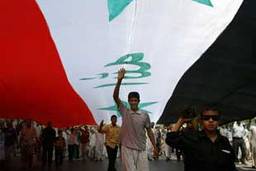Make-a-Sheikh
How the Pentagon transformed a contractor into a symbol of the surge’s ‘success’
David Enders

Sitting in his room on the 10th floor of the Marriott Hotel during a one-on-one interview in July, “Sheikh” Sattar Abu Risha fielded my questions about his fight against al Qaeda with a flourish that matched the oversized stones in his ring and cufflinks.
“I am the leader of all the Arab Iraqi tribes,” he proclaimed, finishing with a look that suggested he was considering whether he had overstated the case. But instead of pulling back, he continued: “In five days time, I will return to Iraq and I will be in my house in Ramadi,” referring to the capital of Iraq’s western Anbar province, where the war has killed more U.S. soldiers than in any other part of the country. “And I say to the terrorists, I will be in Anbar in five days, and if they want to come see me, I am ready for them.”
However, Abu Risha, then the leader of a group of tribes known as The Anbar Awakening, failed to make good on his promise. Instead of leaving Jordan for Iraq, he traveled to Dubai “on business.” (Abu Risha’s card identified him as being a construction contractor more prominently than it identified him as being a sheikh.)
But that did not stop the U.S. military or the White House from touting the “success” achieved in Anbar since Abu Risha first approached U.S. commanders last year and offered to join them in their fight against al Qaeda (after anti-occupation militants killed his father and two brothers). Since then, Anbar has been described in congressional debates as an example of progress, and Risha was presented to the press as a patriot and hero by the military, which facilitated interviews with him.
Since members of Ahmed Chalabi’s political party and the U.S. military helped stage the pulling down of Saddam Hussein’s statue in Baghdad’s Firdos Square, declaring an “end” to a war that had only just begun, the U.S. military and the White House have painted a picture of control and progress in a situation where they had neither.
Attacks and lawlessness in Ramadi, and especially on the road between Ramadi and Jordan, did decline during the first part of this year. But Abu Risha’s critics, including other tribal leaders, say that was because a gang of criminals – of which he was allegedly the leader – was responsible for a good number of those attacks.
When President Bush flew to Iraq for a six-hour visit on Sept. 3 (a week before Gen. David Petraeus and U.S. Ambassador to Iraq Ryan Crocker began a week of congressional testimony), he did not go to Baghdad. Instead, Bush flew to al-Asad Air Force Base in Ramadi for a meeting and a photo-op handshake with Abu Risha.
Ten days after meeting with Bush, a car bomb killed Abu Risha outside his home, despite heavy protection from the U.S. military. Earlier in the year, the military had erected blast walls around Abu Risha’s house and had placed a U.S. tank in front of it, according to an Associated Press writer embedded with the military in Ramadi.
Abu Risha’s death, though blamed on al Qaeda, could have also easily been an inside job, underscoring the American military’s inability to protect so-called allies.
“The Americans like to create characters like Disney cartoon heroes,” said Ali Hatem al-Salman, a sheikh from the Dulaimie tribe, the largest in Anbar, referring to Abu Risha. “Talk is cheap. The problem with the Americans is that they’re working with the wrong people, people who they’ve just brought in off the street. This is the American method.”
Some U.S. military personnel refer to this reconciliation method as “make-a-sheikh.”
The case of Abu Risha reveals a darker side to the U.S. occupation. Abu Risha was a creation of the United States. And while other new allies claim they have turned against al Qaeda, some of these tribes and guerrilla groups have engaged in ethnic and sectarian cleansing and other war crimes, making the American military complicit. In Baquba, for example, the 1920s Revolution Brigade, which kicked out Kurds and Shiites from the city, has now been deputized. In the southern Baghdad neighborhood of Ameriya, a group of particularly feared guerrillas that were once called “terrorists” by the U.S. military are now called “freedom fighters” or “concerned citizens.”
“The Ameriya group is notorious for beheading people and killing people and major atrocities,” said Saad al-Mutalibbi, a member of Iraqi Prime Minister Nouri al-Maliki’s cabinet and the head of the government’s reconciliation team. “These efforts are tactical moves to resolve today’s problems,” he said, “but in essence, you’re adding layers to the problems of Iraq.”
At all levels, the U.S. military and the Bush administration continue to project a reality in Iraq that does not exist – a view that is aimed as much at the soldiers fighting the war as it is at the American public.
In July, two U.S. soldiers sipped Pepsis on a street 10 miles north of Baghdad. They had been fighting in the town three months earlier. “We arrested most of their men,” said one of the soldiers.
The “freedom fighters” ranged in age from 12 to 60-something. But on this summer day, several local Iraqis stood on the street, some waved to the Americans, others mobbed the embedded video camera, smiled, laughed and asked for things. They all wanted jobs. Others stood back and didn’t say anything at all.
After some conversation, the other soldier made the distinction between militants who would attack him and those fighting the Iraqi government, associated militias and the United States.
“We are against the bad al Qaeda, not the good al Qaeda.”







